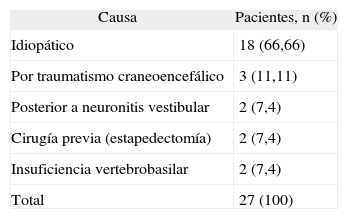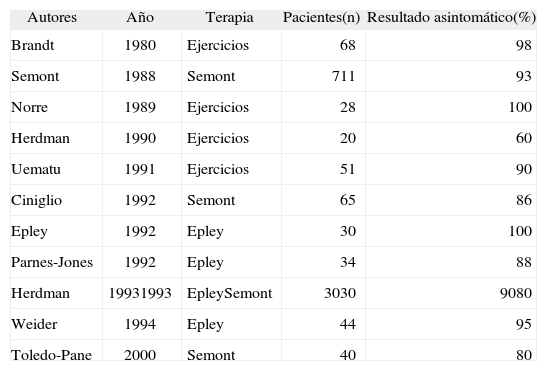El vértigo posicional paroxístico benigno (VPPB) es la alteración vestibular más frecuente. En la mayoría de los pacientes ocurre de manera espontánea y principalmente por afectación del canal semicircular posterior. Su tratamiento consiste en ejercicios de habituación vestibular y en maniobras de reposición canalicular.
Pacientes y métodoSe realiza una revisión retrospectiva de expedientes entre 1999 y 2001 para evaluar una serie de pacientes con diagnóstico de VPPB por afección del canal semicircular posterior, teniendo como objetivo comparar los resultados clínicos que se obtienen con la aplicación de la maniobra de Epley y los ejercicios de habituación vestibular. Se analizan descriptivamente los casos y se compara la respuesta al tratamiento mediante prueba exacta de Fisher.
ResultadosEn el período revisado se encontró a 27 pacientes. El éxito con la maniobra de Epley fue el 100 %. En el 82 % de los pacientes ocurrió 7 días tras la aplicación de la primera maniobra. Se observó recidiva en el 17,6 %. Con ejercicios de habituación vestibular se obtuvo el 90 % de éxito al final del primer mes, aunque disminuyó al 80% para el final del segundo y el tercer mes. Únicamente se demostró diferencia significativa entre las dos modalidades terapéuticas al concluir los primeros 7 días de tratamiento (p=0,01).
ConclusionesLa ventaja evidente de la maniobra de Epley es que reduce de forma importante el tiempo necesario para obtener un resultado satisfactorio, lo que permite al paciente regresar en un tiempo breve a sus actividades cotidianas y que mejore su calidad de vida.
The most frequent vestibular disorder is benign paroxysmal positional vertigo. In almost all patients it occurs spontaneously and mainly through involvement of the posterior semicircular canal. Treatment consists in vestibular habituation training and in canalith repositioning manoeuvres.
Patients and methodA retrospective review of patient files between 1999 to 2001 evaluated those diagnosed as having BPPV due to the posterior semicircular canal in order to compare the response to treatment with vestibular habituation training and with Epley's manoeuvre. The cases are described and analyzed and their response to treatment is compared using Fisher's exact test.
ResultsThe percentage of success with Epley's manoeuvre was 100 %. Eighty-two per cent of patients responded in the first seven days after the first manoeuvre. Relapses occurred in 17.6%. With vestibular habituation training, a success rate of 90 % was obtained in the first month, and this decreased to 80 % by the end of the second and third months. Significant differences between the two therapeutic modalities were only visible at the conclusion of the first seven days of treatment (P=.01).
ConclusionsThe evident advantage with Epley's manoeuvre is that it greatly reduces the time required to obtain a satisfactory result. In addition, it allows patients to return quickly to their daily activities and improves their quality of life.
Artículo
Comprando el artículo el PDF del mismo podrá ser descargado
Precio 19,34 €
Comprar ahora









